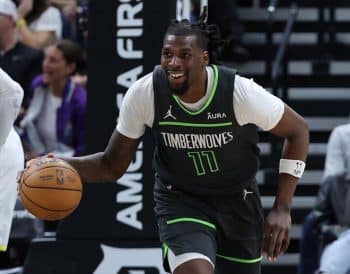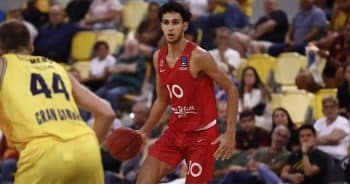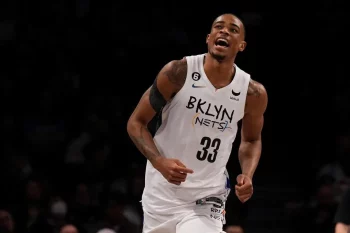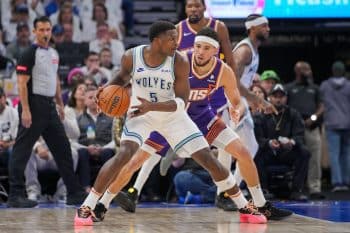NBA
The Genesis of Mike D’Antoni’s Gravity-Based Offense

The term “gravity” in basketball may have been born of analytically-inclined thinking, but at its core it speaks to one of the simplest basketball themes imaginable. In the broadest possible sense, gravity is really just any force that helps pull the defense to a certain place – from the offense’s perspective, hopefully to a place that proves undesirable for defending and makes it easier to score.
To watch the modern NBA, and particularly some of the most potent offenses in the game, you’d assume this kind of basic understanding has been present for decades.
Teams like the Golden State Warriors and San Antonio Spurs base much of their offensive philosophy around manufacturing ball and player movements that will force certain reactions from the defense, then exploiting those reactions. They beautifully leverage the all-world talents of their players; just when the opposition thinks they’ve found the formula, the best of them have organic counters in place to keep them guessing. Watching one of these elite teams, it feels almost laughable to go about playing offense in basketball any other way.
Curiously enough, though, this hasn’t been anywhere close to the norm for the vast majority of the game’s history. NBA basketball has spent easily the largest chunk of its existence as a game based around mismatches and individual dominance, and huge elements of this approach still pervade the league today. My guy is simply more talented than your guy, the thinking goes; you’re either going to have to bring your guy some help while opening things up for someone else on my team, or I’m going to keep pushing that edge.
This isn’t to say there was no teamwork in prior decades of NBA basketball, or even that those approaches were necessarily bad. As recently as 10 years ago, though, the full power of ball and player movement – from all five guys, not just one or two involved in a given play – wasn’t really understood.
And then along came a guy named Mike D’Antoni.
******
As a player in his youth, D’Antoni was part of the formative era of modern basketball. He played in both the American Basketball Association (ABA) and the early NBA during the mid-70s, a period where the ABA was pioneering the use of the three-point line. The NBA wouldn’t adopt the three until 1979, by which time D’Antoni was well into a successful playing career in Europe.
During his American playing days, D’Antoni took note of the way coaches and teams reacted to big structural changes like the three-point line – it was “willy-nilly a little bit,” he says now of the response he saw. Like with any big rule change, it took time for the league’s collective understanding to build about the best ways to exploit the new rules. He saw more of the same once the NBA adopted a three-point line.
D’Antoni made the transition from player to coach in the early 90s, beginning overseas. He hadn’t forgotten the impression those old ABA days had made on him. On top of that, he was influenced by one of the most popular teams in history to that point, the Showtime Lakers – not Magic’s flash or Kareem’s quiet dominance, but rather the raw speed with which the Lakers ran their opponents ragged. The seeds of NBA evolution were being planted.
After some stops in personnel and broadcasting plus a few assistant jobs, D’Antoni was hired by the Phoenix Suns in 2002 as an assistant. Partway into the 2003-04 season, he was promoted to head coach. What would follow would have more of an impact on the NBA and basketball as we know it than anyone could have predicted.
******
We talked earlier about gravity as simply a fancy term for an intuitive NBA concept, and D’Antoni’s offense was the perfect example. Even as they pushed movement and spacing themes harder than anyone in the world had to that point, they weren’t thinking in those sort of terms.
“I’m not sure I ever heard the term ‘gravity’ used,” says Doug Eberhardt, a part time assistant coach and longtime confidant of D’Antoni.
Defining the word in the way it’s used in today’s game, though, is exactly what D’Antoni and his group were getting at.
“You can use all the terminology you want – ‘gravity,’ whatever you want to call it,” D’Antoni tells Basketball Insiders today. “What we just try to do offensively is take all the rules defensively, and go against them… Everything that they preach defensively, we try to do [the] opposite or try and get to a spot they don’t want to be in.”
To accomplish this, D’Antoni drew from his influences: The way Magic and his Lakers kept teams off balance with nothing but sheer speed and decisiveness; the way the entire league was still digesting and processing what the three-pointer was good for.

His system was a hybrid of these ideas, and of other styles. D’Antoni was far from the first to involve multiple players in a given action or use the theme of movement to burn the defense; think of Jerry Sloan’s use of the pick-and-roll in the 90s, for instance.
D’Antoni was, however, one of the very first to realize a concept that seems like grade school stuff to most league thinkers now: If ball and player movement have so much success pulling the defense to places where the offense prefers them, then think about how successful the O could be if the D was never in the right place to begin with.
With that theme in mind, the Seven Seconds or Less Suns were born.
Under D’Antoni, the goal is simple: Put the defense to impossible decisions. Using any and all means necessary, every second spent with the ball in D’Antoni’s system is one where players should be finding opportunities to create two-on-ones that force the opposition to decide between the lesser of two evils.
Much of the foundation for this is in the transition game, which at the time was virtually uncharted territory around the league. Sure, teams would run out on the break if they got a steal up at the top of the key and an easy numbers advantage, or if a rebound bounced long into the perfect place. A few even pushed it further. The majority of NBA offense, though, was played in a set, halfcourt format.
D’Antoni made running the break a cornerstone of his system, and flipped the league’s transition principles on their heads while doing it.
“What’s the natural reaction of the defense when you’re in any transition? You’ve been taught since you’re little that you run to the basket, and protect from the basket out,” Eberhardt says.
Not against D’Antoni’s Suns, you don’t.
“On transition [defense], they want to run back into the paint and pack,” D’Antoni says. “Well, then we’re going to shoot threes.”
Instead of running to the basket in transition, bigs were told to stay outside and keep the lane clear for cutters. Instead of hitting the free-throw line extended and cutting inside for a possible layup or dunk, wings were taught to space directly to the corners – the furthest distance away from where the defense naturally wanted to run. Once teams adjusted to that? Hit them with the counter.
“They don’t want to be out hugging the three, because then you give up layups,” D’Antoni says. “They don’t want to be not giving up layups, because then you’re giving up threes. We’re trying to make it so where they have no choice but to not have an answer.”
They may not have been using the term, but think back to our broad definition of gravity – isn’t that exactly what it’s getting at? The fast break is the easiest way to force a defense into a numbers disadvantage; a numbers disadvantage is the easiest way to force the defense into a decision with no good answers. As Eberhardt puts it: “The gravity comes when you realize who the guy is that you have to cover.”
At first, things may have been a tough sell. Not only were D’Antoni and his staff preaching new concepts, they were the type that required both a physical and a mental commitment. Guys were running more than they ever had before, and while they did it they were being asked to remember principles that ran directly contrary to what many had learned coming up.
Superstar Steve Nash quickly bought in, something D’Antoni credits to this day for helping bring things along. But he readily admits the idea wasn’t universally popular – even certain assistants on his own staff were doubtful.
It’s much harder to argue with results, though, as he quickly found out. In his first full season at the helm, the Suns started a blistering 31-4. They averaged an unbelievable 110 points per game during this stretch, a mark they’d maintain for the full season while just five of the 29 other teams in the league would even crack 100.
“It made it an easy sell at that point,” D’Antoni reflects. “‘Hey, this works.’ And then the players were excited, all of them were averaging career-highs and stuff. So it sold itself in that sense.”
When the pure transition opportunities weren’t there, the layers of D’Antoni’s offense kicked in. The Suns’ secondary transition game may have been just as vital to their success as the actual fast breaks themselves, in fact – they actually never led the league in fast break point metrics, a distinction that was always reserved for the Nuggets and their high altitude back then.
With most other teams at that point, though, a fast break that didn’t materialize led to a reset, then a halfcourt play. For the Suns, there was no reset. The speed and decisiveness of the offense continued to flow.
A big piece of this secondary transition was the drag screen, or a pick the big man sets immediately upon entering the halfcourt (remember, D’Antoni’s bigs were told to stay out of the lane in transition to keep space open). Instead of coming up from behind or to the side of his target from his post down inside the paint, the big man would run the floor and, if the Suns’ transition attack hadn’t already generated a bucket, he would often immediately set a high pick for Nash or another ball-handler before ever entering the key.
Once again, the prevailing theme is keeping the defense off balance. Imagine you’re Nash’s defender, and you’ve just sprinted back down the court and narrowly prevented an easy look in transition. You don’t get a rest: Boom, before you’ve even set yourself and found everyone’s place on the court, you’re running into a seven-footer’s chest and Nash is walking into another deadly two-on-one.
Teams just weren’t ready for this sort of decisiveness. The Suns were playing at a speed that’s fast even for today’s game, which has mostly incorporated D’Antoni’s transition principles – per the tracking site inpredictable.com, they averaged a league-low 13.5 seconds elapsed per offensive possession in 2004-05. That’s a big difference from the league average of 14.8 seconds in 2016-17 and actually dead even with the 16-17 Warriors, the league’s fastest offensive team. If it wasn’t the fast break itself that killed you, it was the secondary action that flowed directly from it.
Even the possessions that mostly resembled traditional NBA halfcourt sets were littered with bits of D’Antoni’s dogma. He ran startlingly few actual diagrammed plays, with a much larger emphasis on the kind of heady “flow” that’s become more and more popular today.

“In the old NBA, a lot of times you just called plays out like, ‘Okay, we’ll call 44 because it’s time John touches the ball,’ or ‘Now we’re going to run 65,’” D’Antoni says now. “How that became the old NBA mantra – I hated that. Players would say, ‘I’m not getting any touches.’ I hate that.
“By having energy, we would tell the guys: ‘If you have energy, you run the floor, you cut at the right times, all that, the ball will find you and you’ll have a career-high.’”
D’Antoni’s battle cry in the locker room while hammering home these principles was simple: “The ball will find energy.” He didn’t teach plays; he taught concepts, then he trusted the best in the world at their craft to execute them.
One such concept is the “bottom-side screen.” Big men in pick-and-roll plays have their own form of gravity – the way they roll to the hoop, the threat of the lob or the layup, and perhaps most importantly in D’Antoni’s eyes, the way they set their screens.
“We really emphasize the energy that the big puts in the last three steps going into a pick-and-roll,” D’Antoni says of a screening scheme that continues to this day. “Where he hits the defense on the pick-and-roll – it has to be the bottom side. You want the defense to go over the top and start chasing the point guard.”
What happens when the defense goes over? You guessed it, another two-on-one. More decisions for the defense, and no great answers. “We’ve got guys good enough that it’s, ‘Once you give me a half-step, I’m taking it. I’m gone,’” D’Antoni says.
The emphasis on screen-setting was never about the action itself. Rather, it was about the speed, the precision and the ultimate result of what you were being asked to do – how your pick spatially influenced the defenders in the play to the benefit of the offense.
“The old sayings, you know, ‘Hold your pick, hit the guy,’ all that – we tried to discourage [that],” D’Antoni tells me. “We put more emphasis and more premium on, how do you get into the pick? The speed. How fast do you get out of the pick? And then the angle that you set it.”
******
As D’Antoni moved through further coaching spots over the years on his way to his current job in Houston, these kinds of little details became more important to maintain an edge. The NBA has long been a copycat league, and others had quickly begun to pick some of the lowest-hanging fruit from D’Antoni’s general theme. Teams ran in transition a bit more opportunistically, looking for chances to catch the defense off-balance. When they played a D’Antoni squad, they were more prepared for what was coming.
The exploits became more granular, but they were still there – and they still all traced back to that theme of gravity.
For instance, D’Antoni has often asked that his spot-up shooters spacing the floor do so from several feet behind the three-point line, rather than just a step or two back. The league took notice during his first year in Houston when guys like Eric Gordon and Ryan Anderson would almost comically exaggerate the gap, but it was actually a well-practiced D’Antoni staple from years prior.
“The original reason Mike wanted them to stop up in that area was so they had the opportunity to catch and step in,” Eberhardt says. When guys like Gordon and Anderson, who can simply make those deep shots at a high clip without stepping in, are on the floor, it’s an even bigger edge. “It makes a huge impact, because the defense has that couple extra steps they now have to close out.”
Another scheme that was present in earlier iterations but really gained steam in Houston is the super-high screen. A common tactic for slowing the D’Antoni transition machine quickly became opponents pressing Nash or other ball-handlers further up the court to disrupt their pace, often a halfcourt press or even further.
When that happened, D’Antoni simply had his screening big come way further out beyond the key to set the pick, even as far as halfcourt. A two-on-one is still a two-on-one no matter where it is on the court, and it’s still going to force exploitable rotations from the defense. Virtually any defense silly enough to press up on James Harden in Houston today is going to get this treatment, and chances are Harden is going to use those couple extra steps to make them pay for it. Even when a team isn’t pressing, the Rockets will sometimes intentionally run high pick-and-rolls that start even further up the floor to give Harden a bigger runway. None of this is going away with Chris Paul, already an elite practitioner of the super-high screen, now in the fold.
Finally, of course, there’s the raw volume of threes being taken in D’Antoni’s offense. His Phoenix squads always took plenty, but perhaps weren’t the outlier many remember: They were actually only first in per-possession three-point attempts twice in his four full years with the Suns, and even these years were by relatively thin margins.
Fast forward to today, and the gap between D’Antoni and everyone else is much larger. His Rockets attempted an incredible 39 threes per-100-possessions for the 2016-17 season, miles ahead of second-place Cleveland at just 34. The Warriors are virtually synonymous with the three in today’s game, but Houston took nearly 33 percent more attempts than them on a per-possession basis.
To hear Eberhardt tell it, though, those same Warriors may have simply galvanized D’Antoni to realize the true destiny of his offensive approach.
“Even a coach like that has second thoughts,” Eberhardt says. It’s easy to second-guess yourself when even your own assistants are doubting you. “[But] with Golden State winning and how the league was bending to his philosophy, now he’s gone full-throttle shooting the three.”
True to form, this isn’t an adjustment where just one part of the equation is considered. Three is more than two, but that’s not the only reason D’Antoni is again the league’s biggest outlier in an important area. Once again, he’s exploiting what he knows the defense’s expectations will be.
Just one NBA team in 2016-17 was in the league’s top five for both shots attempted at the rim and conversion percentage on these shots: The Rockets. And while the credit here often falls to longtime GM Daryl Morey and his Moreyball approach that totally cuts out midrange shots, this interplay is another D’Antoni mainstay.
Think about the trickle-down effect of some of what we’ve talked about: Guys spacing out to several feet beyond the three-point line, then actually making shots from there; D’Antoni’s team firing away threes at a ridiculous rate even for a league that’s historically obsessed with them; wings spacing out to the corner three in transition, rather than running for layups. As a defender going against this attack, what kind of effect does that create?
If you said gravity, good work. All that emphasis on threes and extreme versions of spacing will get you some points organically, sure, but more than that, they’ll pull the defense further from the hoop. What D’Antoni was doing with his seemingly ass-backwards transition spacing in Phoenix a decade ago is now working in reverse – teams are so conditioned to track his team’s threes that they’re willing to leave the vital real estate near the basket wide open.
Another day, another impossible decision for a team facing Mike D’Antoni’s offense. His players won’t always make the shots, of course, and they may not even make the right decisions about which shots to take.
But in a game with thousands and thousands of offensive possessions every year, gravity’s pull starts to make a real difference. No basketball mind has more thoroughly plumbed the depths of this concept, or done so with as much success. You’ll forgive D’Antoni for a singular, fleeting moment of bravado.
“Somebody’s going to be open,” D’Antoni tells me. “If you [do] it right, somebody’s going to be open. We don’t always get it right in a sense of picking out the right guy. But I truly believe: You cannot guard it. Period.”










